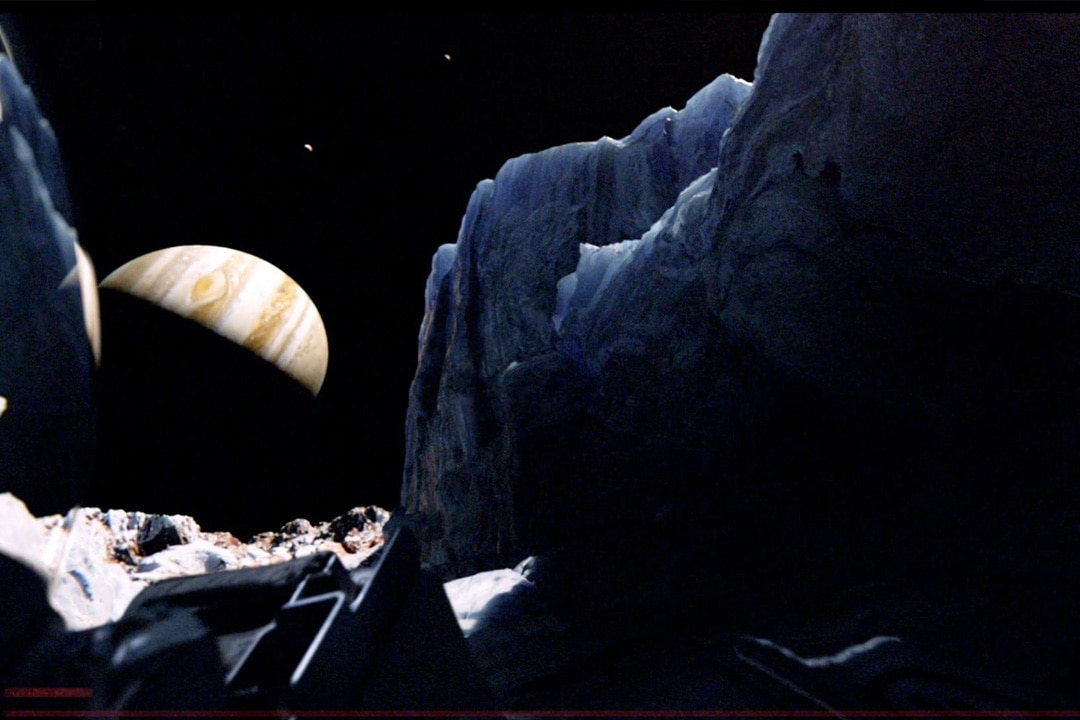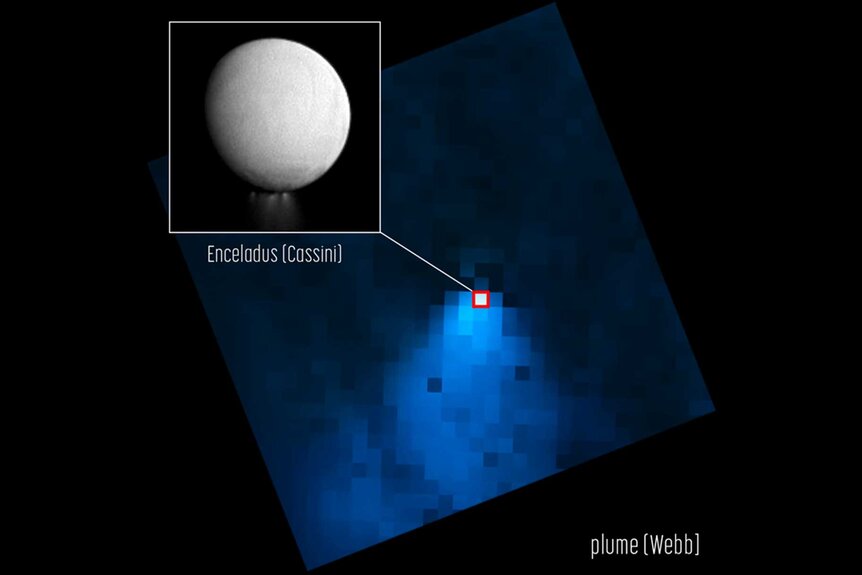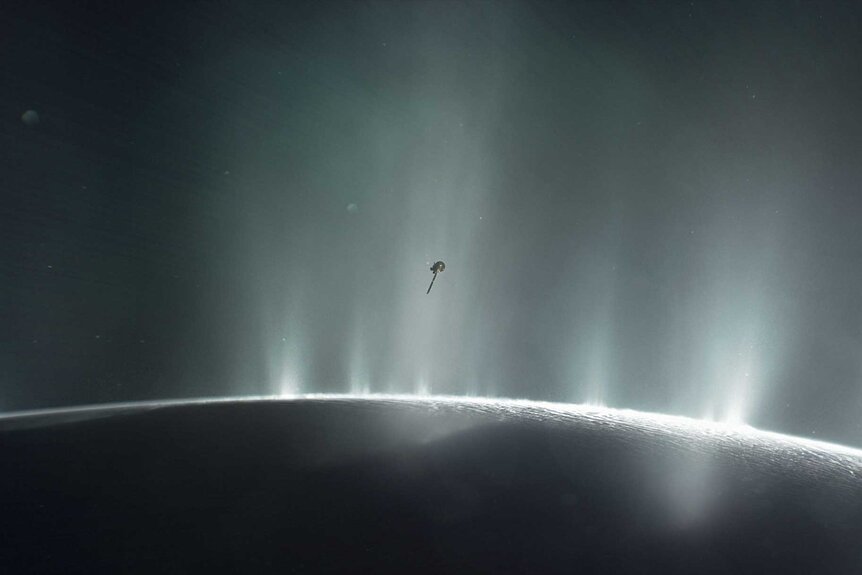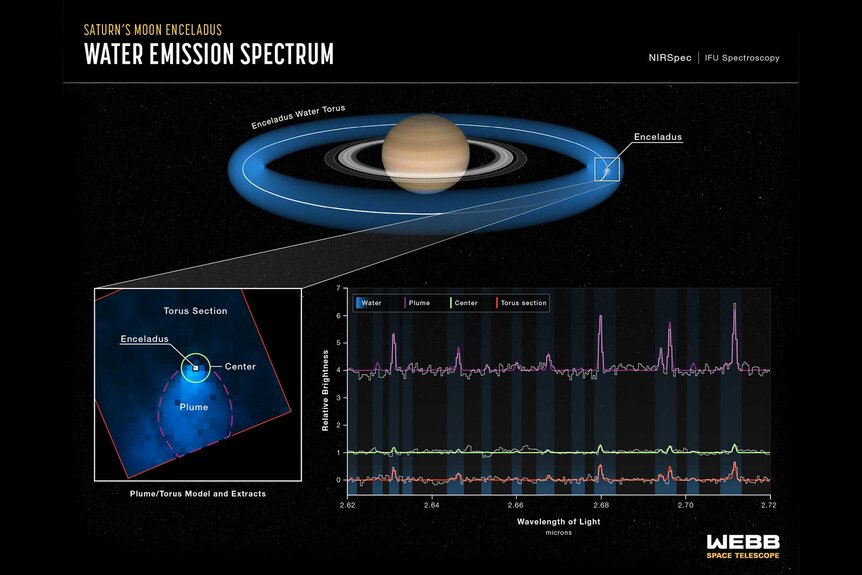Create a free profile to get unlimited access to exclusive videos, sweepstakes, and more!
JWST Reveals 6,000-Mile Water Plume Blasting from Enceladus
That's one serious outburst!

If you’re hoping to find life elsewhere in our solar system, there are few better places to look than an icy moon orbiting a gas giant. Way out in the cosmic suburbs, well beyond the Sun’s habitable zone, are a collection of moons which might have found an unexpected way to make room for life in subterranean oceans beneath their frozen surfaces. Enceladus, a small moon orbiting Saturn, was the first icy ocean world to be identified, and now scientists using NASA’s James Webb Space Telescope (JWST) have identified monster plumes of water, thousands of miles in size, bursting from its surface.
Exploring one of these worlds was the premise of the science fiction thriller Europa Report, streaming now on Peacock. A crew of six brave explorers embark upon the Europa One, a crewed mission to the titular icy moon. Space travel is always dangerous, but it’s especially dangerous if you’re attacked by a vicious tentacled monster from beneath the alien deeps.
RELATED: It’s about time we plan a mission to Uranus — and seek out aliens on Enceladus
Earth is undoubtedly the best place in the solar system for supporting life, at least the kind of life we’re used to. While it might seem like we’re alone in the neighborhood, there are a few places in town where we might find alien life. For a while, Mars was the only game in town. It’s a rocky world with an atmosphere (however thin) and it used to be covered with oceans, rivers, and lakes of liquid water. Mars had all of the right ingredients for life a few billion years ago and may have even supported life similar to our own. Beyond that, we were pretty sure the rest of the solar system was too cold or too dark to support life, but all of that changed in 2005.
THE HIDDEN OCEANS OF ICY MOONS
While cruising through the Saturn system in 2005, the Cassini probe made a flyby of Enceladus and snapped a picture that blew the moon wide open, literally. Enceladus isn’t very big, only about 300 miles in diameter — that’s about a seventh the size of our Moon and only 4% the size of the Earth — and it’s covered over in a frozen layer of icy armor. Not the most hospitable place we’ve ever visited, or so we thought.
The Cassini image of Enceladus’ south pole revealed a massive plume of liquid water exploding out into nearby space. Astronomers identified the presence of fissures in the ice which were considerably warmer than the surrounding area as the potential source of the plume. Finding ejected liquid water at all was exciting, allowing Enceladus to join a small group of worlds with volcanic activity. Though Enceladus’ volcanoes are made of ice, not fire. The discovery was made all the more exciting when the plume was revealed to be hundreds of miles in size, larger even than the moon itself.
Hoping to identify the source of the plume, astronomers made gravitational measurements of Enceladus and calculated the moon’s wobble as it orbits Saturn. They determined the plume was fed by a massive liquid water ocean hiding beneath the ice. Those early images also revealed a terrain with an almost total lack of impact craters, suggesting the surface is recycled on a regular basis. Cassini returned for another flyby in 2008, when it flew through the plume and sampled the water directly. Scientists found evidence of water vapor, CO2, carbon monoxide, and organic molecules.
As Enceladus orbits Saturn it consistently dumps water into space, feeding Saturn’s E ring. Consequently, studying the E ring is a way of studying Enceladus’ ocean without needing an interplanetary scuba suit. There in the ring, scientists found even more evidence that Enceladus might be suitable for life. In addition to ice droplets, astronomers found small pieces of silica. As far as we know, they are only created when liquid water and rock interact at temperatures exceeding 200 Fahrenheit (90 Celsius), suggesting the presence of hydrothermal vents feeding heat and energy into the subsurface ocean.
Suddenly, the hidden oceans of icy moons looked like a pretty good place to search for life. Europa gets all the media play, but Saturn’s moon Enceladus was the rock that started it all.
JWST CAPTURES A MEGAPLUME ON ENCELADUS
While Cassini had the benefit of being on the scene when it snapped its pictures, the JWST has the benefit of improved imaging capabilities. Using the Integral Field Unit inside the telescope’s Near-Infrared Spectrograph (NIRSpec), astronomers were able to capture images and spectral data at the same time. The images were captured in November 2022 and described at a recent conference at the Space Telescope Science Institute in Baltimore Maryland. The results have also been accepted for publication in the journal Nature Astronomy and a pre-print is available here.
Previous observations identified plumes stretching hundreds of miles into space, but that turns out to be the tip of the proverbial ice plume, as it were. The improved resolution of the JWST makes clear that they are much larger. According to the study, the water plumes of Enceladus stretch at least 6,000 miles into space, roughly 20 times the diameter of the moon itself and they exit the surface at a rate of 79 gallons a second.
“When I was looking at the data, at first, I was thinking I had to be wrong. It was just so shocking to detect a water plume more than 20 times the size of the moon. The water plume extends far beyond its release region at the southern pole,” said lead author Geronimo Villanueva, via NASA.
Enceladus orbits Saturn every 33 hours, spewing water along the way. The result is a halo or donut of water in a circle around the planet. Astronomers calculated that about 30% of the water stays in that donut, feeding the E ring around Saturn, while the rest escapes to provide water to the rest of the system. Not only is Enceladus potentially habitable, but it might even be seeding water and organic molecules to other worlds around Saturn. If there is life on Enceladus, we really hope it isn’t tentacle monsters.
Catch Europa Report, streaming now on Peacock!





























